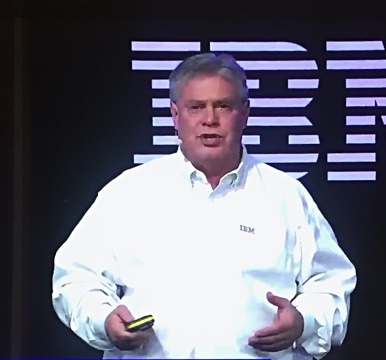IBM Storage has updated the FlashSystem all-flash array hardware and software and is dissing Dell EMC’s “limited” PowerStore array.
The company has made FlashSystem faster, more economical in its protection policies, more resilient and also automated for workflows.

In the launch webcast earlier this week, Eric Herzog, IBM CMO and VP for Storage channels, said FlashSystem arrays are “wildly successful and going gang-busters… FlashSystem is one platform for all your non-mainframe environments.”
There were six individual announcement points;
- Red Hat Ansible abilities to manage consistency groups, snapshots, volume clones, and replication
- Additional storage class memory; up from 4 to 12 drives) with 375GB and 750GB Optane, and 800GB and 1600GB Samsung Z-SSD SCM drives supported
- Redirect-on-write snapshots needing about half the number of write I/Os to storage compared to ordinary snapshots. helping to prolong flash drive life
- New Distributed RAID (DRAID) level 1 added to existing DRAID 5 and 6 levels for configurations with a small number of drives and has less redundancy overhead than levels 5 and 6
- FlashSystem’s Spectrum Virtualize supports double the number of FlashCopy relationships, so customers can store more copies in a system
- FlashSystem can combine high availability HyperSwap and disaster recovery capabilities in a single enhanced 3-site solutio.
IBM’s separate SAN Volume Controller product, which runs the FlashSystem’s Spectrum Virtualise software, also supports the 3-site, combined HyperSwap and DR feature. All these new FlashSystem capabilities will be available starting on November 12, 2020.
IBM singled out Dell EMC’s PowerStore as being limited compared to FlashSystem, with a slide contrasting the base 2RU chassis features from each system.

With the uplift from 4 to 12 Optane or Z-SSD drives, FlashSystem now has 20 per cent storage class memory capacity than PowerStore, uses it as a tier instead of a cache, and can mix it with ordinary SSDs.
The DRAID 1 level is just for entry-level systems, IBM recommending DRAID 5 or 6 for larger systems – because they protect against drive failure better.
HPE is also mounting a marketing attack on PowerStore. Either HPE and IBM fear PowerStore a lot – or they think it’s a competitive win opportunity.








